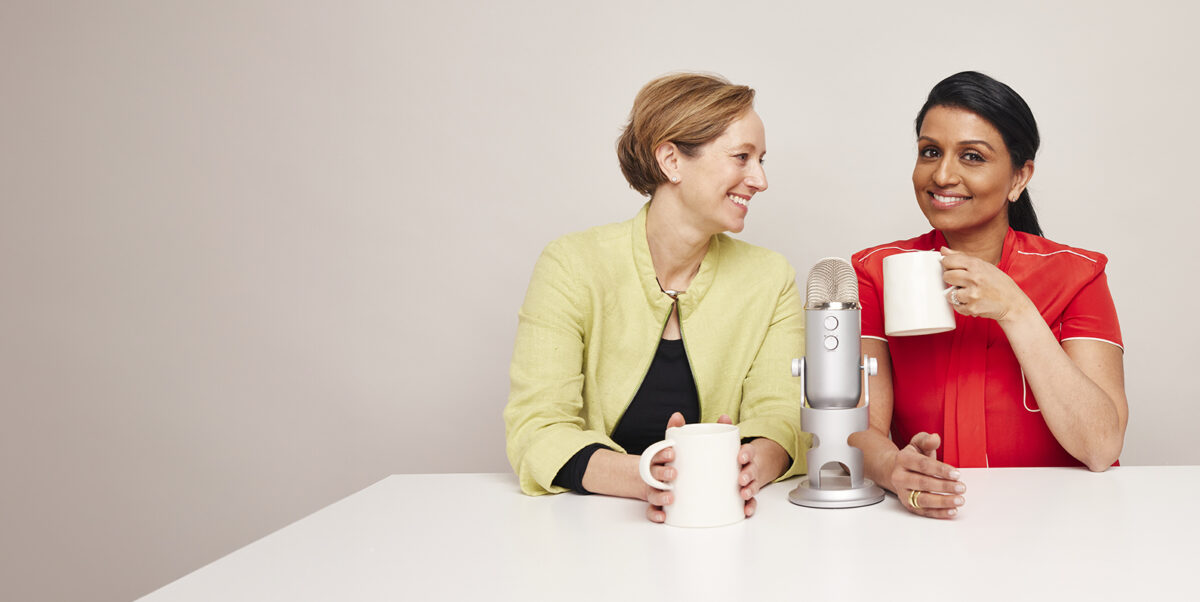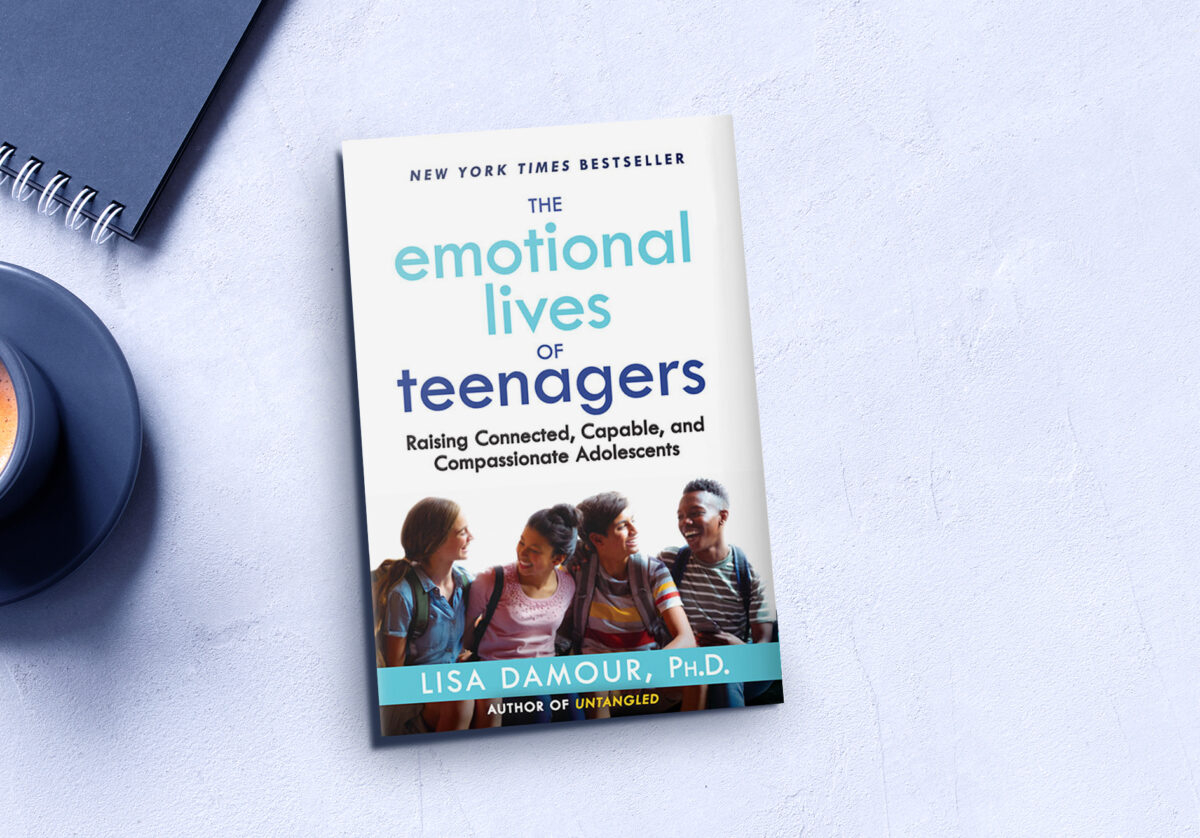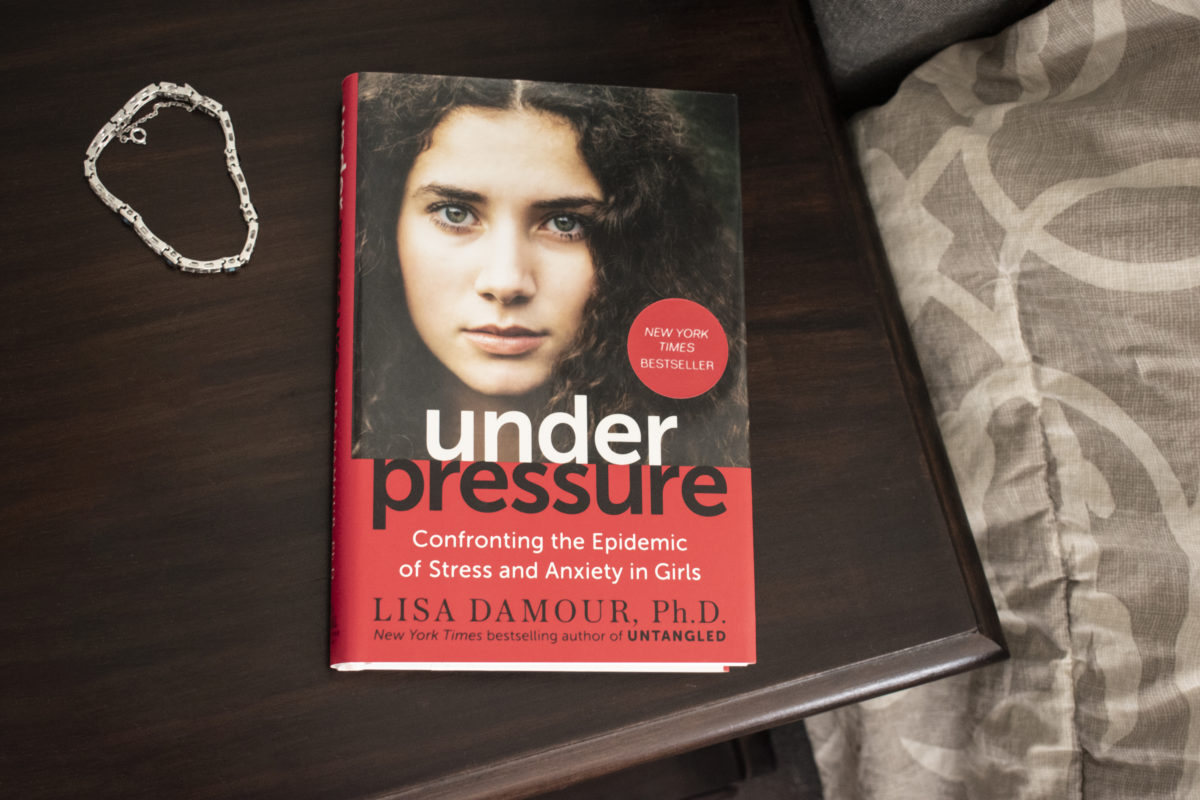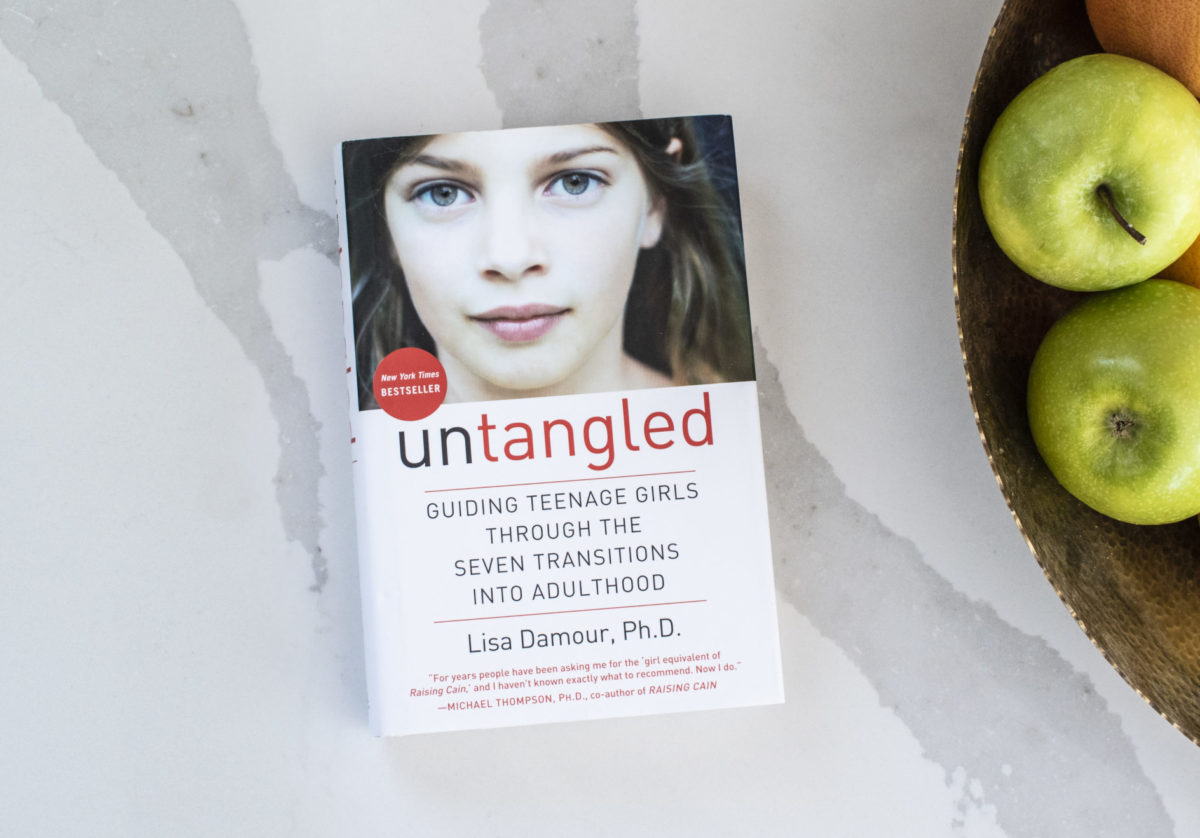Are you struggling to understand ADHD and support your neurodivergent child? Join us for an eye-opening conversation with the Holderness Family, viral content creators who are taking the shame out of ADHD by talking openly about the benefits–and real challenges–that come with the diagnosis. Penn and Kim Holderness dive deep into their personal journey, sharing raw, hilarious, and compassionate insights about living with ADHD, emotional regulation, and building stronger family relationships. We want to hear from you! What’s your biggest challenge in supporting a child with ADHD, and what strategy from this episode resonated most with you?
April 29, 2025 | 39 min
Transcript | Embracing ADHD with Penn and Kim Holderness
The Ask Lisa Podcast does not constitute medical advice and is not a substitute for professional mental health advice, diagnosis or treatment. If you have concerns about your child’s well-being, consult a physician or mental health professional.
The following transcript has been automatically generated by an AI system and should be used for informational purposes only. We cannot guarantee the accuracy, completeness, or timeliness of the information provided.
Reena Ninan:
Episode 217, embracing ADHD with Penn and Kim Holderness.
Oh my gosh. I have watched the videos for the couple we’re about to bring in over and over and over again. It has gotten me through some of the worst times of life. I feel like the humor.
Dr. Lisa Damour:
I know.
Reena Ninan:
And also to see a dynamic married couple nailing it over and over again in the way they do their content. It’s so great.
Dr. Lisa Damour:
They’re so awesome, such a bright light and such a source of joy and also spot on.
There was recently one about husbands not closing cabinet doors. I was like, oh my God, they’re in my house. They’re in my house.
Reena Ninan:
The best way to describe our guest today is one of the coolest families in America. I mean, what more can you say? They’re funny and viral videos
The Holderness Family Video Audio:
Dancing in the front yard night day, and the neighbors walk by and this is what they say Are those Christmas pajamas? They are Christmas jammies.
Hey babe. I was thinking,
Yeah.
I mean, only if you wanted to.
Obviously I want to.
We do have the house to ourselves.
I know.
It is the perfect time.
Never a bad time.
So you want to
Yes.
Yeah. Okay. So if you could just take the coat and get them up to the attic. Maybe we should cover ’em up to the malls. Don’t get to ’em.
Reena Ninan:
The Holderness Family joins us today. Penn and Kim have also co-authored an insightful book called “ADHD is Awesome”. It’s a guide to mostly thriving with ADHD. That’s the title, and they’re going to share their personal experiences and strategies for navigating life with ADHD. And I love the way they kind of flip this concept upside down on its head. Kim and Penn, thank you for joining us.
Kim Holderness:
Hi. Thank you for having us. That intro, I mean, anytime I need an ego boost, I’m just going to rewind that.
Dr. Lisa Damour:
But it’s all true. It’s all true. We just adore you.
Kim Holderness:
Too Sweet.
Dr. Lisa Damour:
Thank you for what you do.
Kim Holderness:
Oh my gosh, thanks for having us. We’re excited to be here.
Penn Holderness:
It is an honor being in whatever kind of room it is with you guys, whether it’s a real room or a digital one.
Dr. Lisa Damour:
Any room, we’ll take it. All right. We have so many questions for you about this book, but I have to do a little just upfront gushing, and I could go on a great length and I’m going to try to contain this.
Reena Ninan:
She doesn’t gush often, just so you know.
Dr. Lisa Damour:
I don’t. I’m pretty does. Okay. So first of all, I don’t know if you know this, how many of my clinical colleagues now make your book required reading for the kids in their care, the families in their care?
Kim Holderness:
Wow.
Dr. Lisa Damour:
Around ADHD and also pretty much anything executive functioning that it is really seen as an essential text to help families understand their kid and connect to their kid and take better care of their kids. So I just want you to know that.
Kim Holderness:
Oh, that’s huge. That’s huge. Thanks.
Dr. Lisa Damour:
It’s huge.
Kim Holderness:
For sharing that.
Dr. Lisa Damour:
And then the other thing I just want to say before we take one more step, and then we’re going to just get down to it. As I was reading through your book, I was like, okay, they have done something extraordinary here, which is they have undercut shame.
And if I think about the forces that I contend with as a clinician that are the most destructive, I don’t think anything outmatches shame. Shame is the most destructive, the most toxic emotion I ever deal with clinically. It is like a black hole that sucks all goodness into it. And in this book that is just like you guys, fun, entertaining, highly engaging and brilliant. You also accomplish a clinical extraordinary thing in taking the shame out of ADHD. And that is just, I cannot overstate the level of accomplishment from the perspective of a clinician. So I want to say all of that before we even get down to business, but I just want you to know that.
Kim Holderness:
You’re going to make me cry because
Reena Ninan:
I’m crying. I’m practically crying.
Kim Holderness:
Yeah. I think that Penn is the one with ADHD, so I should probably let him react to that. We didn’t talk about it in the book, but our son has since given us permission to acknowledge he’s 15, he has ADHD, and seeing it as a mother, seeing the shame monster related to ADHD kind of grab hold of this bright, perfect brain. It is such a real thing, especially with ADHD. And just to hear that is so huge. So thank you.
Penn Holderness:
We can talk about this as much as you want to, but the book came, it’s a fun book, but it came from shame. That’s the reason why I wanted to write it. I got picked on a lot and I didn’t know why I felt ashamed and I didn’t know why. I did not understand what exactly it was. It was wrong with me and why I didn’t fit in the way that everybody else did. I can’t go back in time. But the hope was that maybe some other people can understand this and use it as a tool when they’re trying to grow up or even be an adult. It does follow you into adulthood.
Dr. Lisa Damour:
Yep. Oh, man. It’s such an accomplishment. Okay, so we’re going to start asking you questions. We’ve got some from us and some from our listeners, and we’re just dying to have this conversation. Okay. So in the book, talk us through, Penn, how you got the diagnosis, when you got the diagnosis, what it felt like to get the diagnosis, if you had suspected before you got the diagnosis that maybe you had it. Talk us through all that.
Penn Holderness:
Yeah. Well, I’m old enough that no one was curious if they had it because it wasn’t a name that people said, I’m 50 now. So I was in the playground in the late seventies, early eighties. I was in college in the early nineties, and I knew that there was something different about me and I got through school largely because my Ritalin was my mom. My mom, she was the drug that kept me on track, that crossed the i’s, crossed the T’s and dotted the i’s for me, kept my room clean probably to the extent that I needed to learn how to do that when I got married, a little bit better for sure, but really kind of was over my shoulder for schoolwork, and I did well enough in standardized testing that I got into a good school. But as soon as I got to school and my Ritalin was gone, which is my mom, I crashed.
I went on academic probation twice. That’s to say I almost flunked out of school. I had a friend who mentioned she had ADHD and that I clearly had it when I was in my third year in college, but there was no way of really knowing that same year I was at a funeral for my grandmother, and it’s so funny, a lot of fidgeting and stuff happens during stressful points. Our family was sitting around talking about what we were going to do with our beach weekend that we always do. Both the grandparents were now gone, and this really important part of my life, this two weeks, every summer when I get to see my cousins was going away and I was sitting there thinking about it, stressing out and very, very sad. It was probably the saddest I was the entire weekend, even though my grandmother had passed, and my Aunt Zelle in the middle of this conversation, she goes, Hey, I’m sorry I cannot concentrate on this conversation. Penn, would you please stop chewing on that fly swatter. So it was a used fly swatter, a used, dirty Carolina where there are a lot of flies.
Kim Holderness:
It’s heavily used, heavily used.
Penn Holderness:
Heavily used fly swatter, and everyone laughed. I’m glad I gave them a chance to laugh. That was nice. But I was deeply embarrassed, and so I was old enough to drive myself to a doctor at that point and say, doc, this just happened. They had these little computer tests and diagnosed me with a scorching case of ADD, I think it was ADD at the time.
Dr. Lisa Damour:
I think that’s right. But also you use the term scorching case in the book and you tell the flyswatter story in the book, and I’m like, this is so good because again, about getting past shame and this is what this looks like. It does not need to be a source of shame. It needs to be understood.
Reena Ninan:
Kim, I am just curious, as someone who’s with someone with ADHD, what were some of the first challenges you noticed? How did you have to navigate this and work through? Because I think a lot of parents who might not have ADHD don’t even know where to begin and what to look for.
Kim Holderness:
I will first start by saying that all of Penn’s ADHD, his quirks and spontaneity, and that was part of the charm. So when we first started dating, when we met, he was the life of the party in high school. He’ll tell the story in middle school. I mean, he had trouble maybe connecting with groups and making friends, but as an adult it was amazing. So that’s really what I fell in love with. Then of course, you get into relationship and then you live together and you’re like, oh, wow, really? It wasn’t even an awareness in his brain, putting things away, closing cabinet doors, putting laundry away, those things. And I had to learn that he walks in the door, he can’t find his keys in the morning. So we retrace his steps because I know that his memory, his working memory, he’s so hungry. He goes straight to food.
He puts his keys in the refrigerator to pull out the sandwich.
Dr. Lisa Damour:
Naturally.
Kim Holderness:
Naturally. So I’m like, okay, we know to look near food for things because that’s all. So it took me years. It took me years to realize that he wasn’t doing this just to piss me off because we would talk about these things and I’m like, why can’t you? And even with my son, I’m like, you did the homework. Why can’t you just turn it in? And I really had so much learning to do that those really easy things are really hard for that type of brain. It’s easy for me, but I had so much learning to do, and part of that was offering grace in those moments, offering those great when we can’t leave because we can’t find the keys again. It is what it is. We just have to let things go. So I’ve learned a lot through this process.
Dr. Lisa Damour:
I learned so much reading your book. I mean, this is obviously my field, but just the way you wrote it, and I actually feel like everyone should read this book because everyone’s going to interact with a person who has ADHD, whether it’s a relative or an employee or a boss or a colleague, and the amount of compassion that it helps one cultivate and understanding and appreciation for the ADHD brain. I just sort of feel like this is just a good book for humans to have read no matter what across the board.
Okay, here’s a question from one of our listeners. How do I talk to my kid who’s a tween about the fact that we’re going to have him evaluated for ADHD?
Penn Holderness:
We get this question a ton, and as a non-doctor, I struggled to give a really, really good answer except to come at it from a place of love and understanding and not a place of frustration. Because a lot of times when you are asking that question, it’s because you’ve reached your wit’s end and you don’t understand why this person can’t do the things that are easy, at least seem easy to you. So my advice is to start with something like they’re good at something that a strengths-based approach, something that they’re knocking out of the park. It’s pretty amazing how creative you are. It’s pretty amazing how when you really care about it, you can really drill down and I mean maybe even be great at playing a video game, whatever it is that you can dedicate your mind to and actually accomplish and say something like, that’s amazing. I can’t do that. You can do that. But I’ve also noticed that there are some things that maybe are more difficult to you, that are easier to other people. There is a condition that explains this. It is a brain difference, and there’s a way to diagnose it, and if you have it, we can get you pointed in a new direction that you might actually really like. It’s so hard.
Dr. Lisa Damour:
I thought that was awesome.
Kim Holderness:
We had to, well, our son, we just assumed he had it, but it was recommended. Just make it official. Just make it official, just so if he needed accommodations down the road. So he was diagnosed in seventh grade, but still he kind of resisted it too. What does it matter? This is my brain. How we explained it to him at the time was, it’s just good to know about what kind of brain you have, and these sort of testings can kind of tease out what you’re really good at and how you would learn best. So if you need to have a separate place where you’re taking tests or whatever it is, you need this documentation to do it and we’re having to redo it again, you have to redo it every three years. So you just went through it again. It’s a lot.
Dr. Lisa Damour:
Yeah, no, it’s a whole thing. But I also like the kind of matter of factness that you’re like, this is just how this works, and it just is going to teach us things, and then it’s going to help you learn better and point you in a direction. I love Penn, what you said about pointing you in a direction I think you might really like. It’s so gentle and so kind.
Reena Ninan:
I love what you do in this book about turning the concept. Penn, you said it was called ADD Attention deficit disorder, focus on the deficit that you can flip it a little bit by saying it’s not a deficit, it’s an abundance of attention. How do you reframe that? So I’m just curious, if you’re living with ADHD pen, how do you harness this abundance effectively and make it look cool or like a skillset? Because I look at what you guys have built together and how now hearing from the ADHD lens, your attention to all this stuff is remarkable. It’s just fabulous to see what you guys have turned out.
Penn Holderness:
Yeah, self-awareness is a pretty amazing weapon. Once you’ve realized what you have and the cards that you’ve been dealt, and that’s a real problem for people with ADHD. They don’t know what their hand looks like, right? They’re not really sure how to get the most of what they’ve got. So once you get the diagnosis and you hear, oh, so when I leave the stove on, when I put one sock on, go downstairs and something else happens, there’s an actual medical explanation for my working memory and the fact that it does not seamlessly go from one to the other. When you leave one task, the other one not only is still there, but it’s no longer in your head, it’s left your working memory. So getting the physics of that was really nice for me to understand because then when something happened, the shame goes away.
You’re like, oh, okay. Well that’s just, that’s my brain. Then step two is sharing that self-awareness and dedication with the people that you love and the people who love you. So Kim, I’m sure was at her wit’s end very, very early on in our parenting journey because that was inflection point where my executive functioning started to break down a bit, and she saw it as a sign of disrespect, understandably. And so she learned these things and said, well, okay, this is his brain. We’re off to the races, and as she said before, can give some grace and understanding back to me. I have to say, okay, I’m going to work my patootie off to make sure that I get the most out of my brain and not leave stuff out in the middle of the kitchen. That symbiotic relationship sets you up for success because what’s left once that’s all done and you’re not just leaving stuff all over the place, and if you’re a kid in school, you’re not forgetting to turn in assignments because you make a note of it and you put systems in place to make sure it happens. Then what’s left is creativity, spontaneity, this amazing ability to, when you say you’re being fixated sometimes and that can be bad, you’re off somewhere creating or understanding something in a way that no one else has ever understood it before. I believe that my originality and my creativity is coming from the exact same part of my brain that almost burns the house down.
Dr. Lisa Damour:
It’s perfect. That is the perfect summary of this.
Kim Holderness:
Well, I mean, I could call up the picture right now. So in the beginning when I say like, oh, I offer grace and I sound like a saint, trust me, there’s frustration. But it’s because my son and my husband work so hard. They are writing notes, they have calendars, they have alerts, they are working, and I see them working so hard and it’s not easy. So because they’re doing that, I can offer the grace. But there was a particularly busy morning last week, and Penn and I go to the gym together twice a week and he shows up and he looks down, he goes, I don’t have shoes on. So he got to the gym, but he had done literally everything else. He got a permission plan and we had to sign a contract for this, and we had to drop something off on the way and a kid to go here. He’d done all of these things, 10 out of 10, and he’s like, well, and so what do you do?
Dr. Lisa Damour:
You swim, you go swimming.
Reena Ninan:
Oh my gosh. It’s hard for me to somebody who doesn’t have a touchpoint to ADHD, it’s hard to understand. Wait, how can you, I would’ve done the reverse. I would’ve missed everything else and not done anything, but gone to the gym with my shoes.
Kim Holderness:
Exactly in my brain too. My brain, the shoe, you could feel the concrete on the way out the door. That’s a cue that I don’t have shoes on or that my favorite and my love, my family. But there are black clouds outside and the trees are blowing. I’m like, my brain that looks like rain’s coming. I better bring an umbrella. And Penn walks out the door. He is like, it’s not raining right now. I guess I’m good for the rest of the day. It doesn’t cue. So I just know that that is the difference in our brains. I can feel the concrete. He’s moved on to the next step.
Dr. Lisa Damour:
You’re bringing this to a question, and you did such beautiful job in the book of saying this is very varied. ADHD looks different in different people. It occurs across a continuum. But if someone is listening to this thinking, okay, now I’m starting to wonder if my kid or my partner or whatever might have ADHD, what are the kinds of things you would have them looking for?
Penn Holderness:
Yeah, so I want to start with the fact that this is just a medical diagnosis, and this happens with a lot of disorders, is it can’t just be present in one facet of your life if you’re spacing out at work, but not at home. If you’re having trouble at school, but not at home, it has to occur across, I think in the DSM, they said at least two of these venues and you have to look back at your history and it has to have been present in childhood as well in some way. And a lot of times you can retroactively go back and say, oh yeah, I had this problem. And that’s kind of a way to weed out this kind of attention related addiction to phones and a lot of other things that are going on.
Dr. Lisa Damour:
There is the coolest chart in your book that’s like ADHD attentional difficulties for someone who doesn’t have ADHD. And then some third hilarious column was, it was like tuna sandwich or something. It was so funny. But
Penn Holderness:
Then the third one was concrete. I couldn’t
Dr. Lisa Damour:
It’s some random thing, but it was so brilliant about has difficulty focusing everywhere when caught on one’s phone. It just moves across and it’s such a brilliant way to make the distinction between how so many of us struggle to focus our attention in a digital soup of our lives versus having ADHD.
Penn Holderness:
So there’s an acquired attention disorder that some people actually can be diagnosed with, and I think the treatment is get off your phone.
Dr. Lisa Damour:
Yes, put down your phone. Exactly.
Kim Holderness:
I have had to break myself. I used to scroll a lot and I am much, much better about it now. I think there is some blow back. There’s a lot of people who say everybody has ADHD nowadays. I’m just here to tell you, there’s a difference between what I have in perimenopause. It feels like inside of my brain’s a snow globe I could buy. I’m like, is this ADHD? But I think it’s just perimenopause and too much TikTok. That’s what my issues are. What happens to my husband is completely different. And so people that criticize like, oh, they’re just handing out diagnoses. No, no they’re, no.
Dr. Lisa Damour:
If you’ve seen it for real. It’s a different thing.
Kim Holderness:
I think when you asked what to look for again, as somebody who does not have it, and I’m not a physician. We went on this book tour was so, it was so lovely.
Dr. Lisa Damour:
Because of the shame dispelling you did. That’s what it was.
Kim Holderness:
It was just so nice to hug these people. There were so many moms that they read it because their kid has ADHD as they were reading it. They’re like, oh crap. This describes me as a child. So many moms got diagnosed because it looks so different in women than men.
I’ll say if you’re an adult woman or a you have a girl at a teenage girl at home, those symptoms are going to look a lot different than the traditional hyperactive boy. So the symptoms are vast and varied. I love that they’re just now, the reason why we don’t talk a lot about women in ADHD is because they’re only now starting studies. Duke has a center for ADHD for women and girls, and so they’re just now starting these studies and I hope that we learn more about what it looks like in women because
Dr. Lisa Damour:
A hundred percent.
Kim Holderness:
Yeah, I think it’s a lot of the moms describe a lot of easy overwhelm. Things fall through the cracks, but they’re, they’re not hyperactive. So there’s just a lot a to look for.
Dr. Lisa Damour:
And I’ll weigh in as a clinician. I mean, we’ve long known we miss the diagnosis in girls because they’re not frankly bothering anybody. They are quietly sitting in the back of the class missing 90% of what’s going on, whereas boys are more likely to be missing what’s going on and also cutting up having a hard time sitting. And so we do know that we often end up with a delayed diagnosis for girls if we ever even make the diagnosis because the behavioral piece isn’t present in the same way usually.
Kim Holderness:
And they can mask so well, and it makes me so sad that then that inattentive girl who struggled in school is now a mom and feeling shame over, oh my God, I just missed another signup genius. I can’t handle all this stuff. And they’re in tears. And maybe it’s not medicine, but maybe there’s a coach, an ADHD coach, and there’s, there’s things to do.
Reena Ninan:
Can I say we’re talking a little bit about what’s inside the book? I love first the cover is awesome, this gorgeous cover. But you know what I really loved is it’s like color coded.
Dr. Lisa Damour:
Yes. This is so cool. All the chapters have their own color on the side. It’s the coolest thing.
Penn Holderness:
Well it was intentional. And then we learned so many things from this tour as Kim noted. I think most of the kids who showed up had a book with them that they’d already bought and they wanted us to sign it. And I would say about half of those kids, maybe more. And there’s got to look into this research on this had tabs and post-it notes all through it of things that they wanted to underline and a headline and remember. So those color-coded things. It was funny. We made that as like, oh, well, maybe they’ll do this. They actually were doing this, particularly children were using these little earmarks in dog marks inside the book to kind of know so that by the time the book came to us, it was an even more colorful
Kim Holderness:
And it was like this thick.
Penn Holderness:
I’ve never really asked anyone about that.
Reena Ninan:
I thought it was intentional. You see the chapters are highlighted.
Penn Holderness:
That was, we just didn’t know that kids were actually just doing that on their own.
Dr. Lisa Damour:
I mean, the book is so fun and funny and all the asides and all the wacky stuff that’s in there that is just so entertaining. But it’s almost like you gave the kids permission to use the book the way they needed to use any book. You kind of figure, you can see these kids with a very dry book with none of the fun stuff in yours feeling like, well, I guess I just can’t really touch it or mess with it or make my own notes. Your book is like, color me. Go for it. Go for it. We’re already halfway there. Keep going.
Kim Holderness:
There’s these little post-it notes kind of graphically in there. And that came because once you’ve done books and you Penn and I like to have it printed and read it actually instead of the word doc. And so he was putting all these post-it notes and he was doing all these drawings. We’re like, well, that’s it. That’s the book.
Penn Holderness:
We’re just going to put those in the book.
Kim Holderness:
Our publisher blessed them. They were very patient with us.
Dr. Lisa Damour:
Well, and in that way, there’s something about reading the book that cultivates compassion. Like, oh, this is what it feels like a bit to have, because I am a school brain the minute I was born. And I’m like, oh, cool, all this cool stuff all over the place. And then I was like, oh, this is what it’s like. This is what it’s like.
Kim Holderness:
Yeah. You mentioned what was the thing about you can walk through a whale’s vein or whatever, but that is what happens in the conversation with my husband and son. We’re in the car and it’s great, but we are driving down the road and the conversation starts here and then all of a sudden it’s here and it’s wonderful and entertaining, but that’s what an ADHD brain does. And so the book was written to try to captivate so that somebody with ADHD would actually read it.
Penn Holderness:
I had an awesome editor who, it’s so funny, she’s one of these people who doesn’t like me to say her name. I don’t care. Becky Cole, she’s amazing, unbelievable. And she acted as kind of my task manager for this book. And so we realized very early in the process of how to edit this book, that there’s a through line and we get the through line done. And then on the second run through allow your brain to wander and include that in the book so that people with ADHD aren’t going to get bored to death and are going to get a picture of a person swimming through a whale’s blood vessels. And so that was another one of those very intentional things that we did, and we were worried about how it would work with the audiobook, but apparently that works as well because you can be listening and want to go on these diversions as well. But the fact is the ADHD brain cannot go through a chapter at a time. It’s too much without having some fun diversionary activities.
Reena Ninan:
We were talking a little bit about family dynamics as well. I want to get into that before you guys go. The emotional intensity of dealing with ADHD, do you guys have any family strategies that really work for you guys to pass on to other families who are dealing with it?
Kim Holderness:
This is a deep breath moment. I will just first acknowledge that it’s very hard and I think it’s hard for everyone. I may not have the best advice, but I can just, I see you and I know it’s hard. I was also unaware that ADHD, a big component of it is the emotional dysregulation. I didn’t understand why the things that were sad were so sad and the things that worth being angry about got so I just didn’t understand. I’m like, you shouldn’t be so sad. You just lost a basketball game. Why are you crying? I didn’t act like that, I promise. But in my brain, I’m like, you’re going to play one tomorrow. It’s fine. Penn did a really good job of explaining to me, he was like, listen, I cried into high school after losing a basketball game. This is just what this brain does, and it’s a delay. So I would just say from what I’ve seen in our family and then people close to us, it gets better. It gets better as the brain kind of grows and adjusts. But it’s always there. And it was hard as a mom. The emotions seemed outsized. And that’s again where when I could just get down on the floor too and offer some grace and just be really calm. I didn’t match the intensity. I didn’t try to talk him out of it. It got better and age has made it a lot better.
Penn Holderness:
The worst shame comes from not being able to regulate your emotions. That’s the toughest part.
Dr. Lisa Damour:
That’s like the white hot center of the shame.
Penn Holderness:
When your body and your age appear to have gotten you to the point where you can tough it out and you just can’t as much as you want to, you can’t keep that flood from getting right into your brain and your heart and making you cry. That was the toughest part of my childhood, and it’s the toughest part of my child’s childhood. He’ll even tell you that. And he’s worked hard on it. I think now that he understands his brain, he’s less likely to get to that point. But it’s really tough. And it may be until college, until you learn how to properly regulate these emotions. I’ll echo what Kim said, and we have this kind of guru named Marcy Caldwell, who’s fantastic, who very early on said 100% of my clients who come in with their children are not prepared for the emotional part of it and know nothing about it.
Dr. Lisa Damour:
It’s not in the diagnosis. Nope.
Penn Holderness:
It’s nowhere.
Dr. Lisa Damour:
That is. And you’re right, we don’t talk about it enough. I don’t know that clinicians do enough good educating about it. I don’t even know that clinicians are always as knowledgeable about it as you are, right? I mean, I will say that mean unless they specialize in this very, very deeply, you’re bringing a knowledge base that I think a lot of people don’t have. Alright, we’re going to start to, we could talk to you forever, but we also know you have lives. Okay. So say we’ve got a family who’s listening to this and they’re like, I think there might be something here besides getting your book, which they should have done yesterday. What would you have them start to do by way of moving forward to try to make sense of and help their kid with a possible diagnosis of ADHD?
Penn Holderness:
I mean, a pediatrician can diagnose it.
Kim Holderness:
In a very clear, in a very straightforward case.
Penn Holderness:
In a clear case, and they can prescribe medication. But my one real thing I would say is, please don’t stop there if that’s what you’re doing. It’s wonderful that pediatricians can do this and they will do this, but using only medication to treat ADHD is going to be putting lipstick on a pig for the rest of your life. If you don’t get either some advice from a coach or a psychologist or someone to better explain what’s going on in your brain and then really do as much as you can to try to put systems in place to alleviate that hard stuff, that’s easy for everybody else. Because if you just take the drugs, you’re going to do better, but you’re not on the drugs all the time at night. Sometimes they wear off in the mornings. Sometimes you have to take breaks. You might decide that you want to wean yourself off of medication and then you’ll just be left with what you started with.
Dr. Lisa Damour:
So all around services, not just one thing.
Kim Holderness:
And I think the systems are even more important if I can do that and listen, a pediatrician can do a straightforward diagnosis, but what we’ve been told, sometimes ADHD walks hand in hand with anxiety and having to tease out what’s anxiety and what’s ADHD a good therapist can do, but man, it’s hard to get in to see a therapist. So I would also say, and I wish somebody had said to me earlier, even if you’re just hinting around it, get a diagnosis sooner rather than later. Especially with school, even if you don’t use the accommodations, you have to kind of be on record that they exist. And
Dr. Lisa Damour:
Certainly if you try to use them in college, you can’t just decide that day that you want to.
Kim Holderness:
Right? Yeah. You can’t just show up and say like, oh, my kid needs extra time in the SAT, they get overwhelmed if they, no, you haven’t used, we’re not going to do that. So if you think it is, just get those accommodations or get on the record as soon as you can.
Dr. Lisa Damour:
Wonderful. Well, I mean Reena, are they the greatest, I mean?
Reena Ninan:
Oh my gosh.
They just from the videos seem so cool and down to earth and you always have confirmed that. And then meeting them now today on the show, you guys are just wonderful. By the way, I just want to let our viewers know. If you’re watching the YouTube channel, we had a set issue and there was pen within three and a half minutes, had figured out what would have paralyzed me for the next hour that we would’ve had to cancel our taping today. And I just was in awe watching him put it all together.
Dr. Lisa Damour:
And then we were like superpower in action. We’re watching it right here right now.
Reena Ninan:
Absolutely. You guys really are the coolest couple in America. When can we hang out in person?
Penn Holderness:
I would love that.
Reena Ninan:
Well, the book is called “ADHD is Awesome, A Guide to Mostly Thriving with ADHD”. Boy. It’s got a wealth of information and practical advice.
And check out our show notes. We’ll have a link to the book in our show notes as well.
I just can’t wait to have them back on. That’s all I can say. They’re just doing such. But until you said it as somebody who doesn’t know anyone in my family who has ADHD, I don’t know. There are moments, Lisa, where I read it and I’ve asked you before, do I have ADHD? Sometimes I do have trouble focusing, and you’ve told me I have it. I don’t have it. But there are perimenopause things that Kim was talking about that I feel like I relate to. But what I did not realize the book did that you said was taking the shame out of this. I just thought, wow, they’ve turned this upside down on its head in such a cool way. But you do not need to have ADHD to read this book. Please. I found it so valuable. So valuable. I’m going to be gifting this book, I’ll tell you that. So Lisa, tell me, what do you have for us for Parenting to Go?
Dr. Lisa Damour:
I talk about the beauty of being a mid to late career psychologist, or hopefully just mid at this point, and things start to become clear. Things just boil down into simple forms that just make so much sense. And the place I’m at right now is that everything is about relationships. Everything good that happens, especially in family life, especially between parent and child, is about the quality of the relationship. This book is about shame, getting rid of it. And then this book is equally about relationships. And there’s something so beautiful that happens in this book of Kim’s voice and Penn’s voice and them talking about the impact of ADHD on their relationship and how they use the relationship to get through the parts that can be hard about ADHD. And I put it down and I was like, this book is going to do so much for the relationships around kids who are struggling with this, and there is nothing that matters more in the care of our children than that.
Reena Ninan:
Wow. You know, you also made me realize, I wanted to ask them how do they work together as husband and wife? Could you do that? I couldn’t do that. Back on to ask about that.
So Lisa, I will see you next week.
Dr. Lisa Damour:
I’ll see you next week.
More resources

















